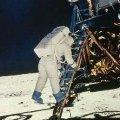U.S. astronaut Neil Armstrong made the historic first step on the Moon from Apollo 11 's landing craft called the Eagle. Armstrong summed up the momentous event with one simple, elegant phrase: "That's one small step for man; one giant leap for mankind." The moon landing was seen as the high point of a U.S. space program fueled by a decade-long space race with the former Soviet Union. Twelve years before the historic Apollo 11 mission, the Soviets successfully launched the first artificial satellite called Sputnik into Earth's orbit. The accomplishment was soon followed by cosmonaut Yuri Gagarin's historic manned spaceflight into Earth's orbit in 1961. That same year, then President John F. Kennedy vowed in a speech before the U.S. Congress to put a man on the moon.
"I believe that this nation should commit itself to achieving the goal before this decade is out of landing a man on the moon and returning him safely to Earth," he said. The U.S. Moon mission came on July 16, 1969, when Armstrong, along with astronauts Buzz Aldrin and Michael Collins, climbed into Apollo 11 's command module called Columbia atop a gigantic Saturn V rocket and blasted off. It took the Apollo 11 four days to enter lunar orbit.
On the far side of the Moon, out of communication with mission controllers, the Eagle moon lander separated from the Apollo command module. Upon descent, alarms went off telling the astronauts that the automatic guidance system was steering the lander toward a boulder-strewn crater instead of a relatively flat landing site called the Sea of Tranquility.
Neil Armstrong took manual control of the guidance system and, with just 20 seconds of fuel remaining, coasted to a landing.
The tense moment had ended as Mr. Armstrong radioed mission control.
"Houston, Tranquility base here," he said. "The 'Eagle' has landed." Armstrong carefully descended the steps of the landing module 6.5 hours after touching down on the powdery lunar surface.
Neil Armstrong described the landscape.
"It has a stark beauty all of its own," he said. "It's much like the high desert of the United States. It's different but it's very pretty out here." The president at the time, Richard Nixon, watched the breathtaking event on television with the rest of the world. In a telephone hook up to the Apollo 11 astronauts, Mr. Nixon paid tribute to their history-making accomplishment.
"Because of what you have done, the heavens have become a part of man's world. " During the two-and-a-half-hour moon walk, the astronauts frolicked in the weightlessness of outer space and planted an American flag in the lunar surface. They conducted several experiments, gathering up lunar rocks and soil.
More than 21 hours after their famous walk, astronauts Armstrong and Aldrin fired up the Eagle and rejoined Mike Collins aboard the Columbia command module for the flight back home.
Astronaut Neil Armstrong, the first human to step on the Moon, observed the extraordinary accomplishment of the Apollo 11 mission forever established a lasting legacy in space flight.
"The important achievement of Apollo was a demonstration that humanity is not forever chained to this planet, and our visions go rather further than that and our opportunities are unlimited." Thus began the modern space age and the promise of future space exploration.
Jessica Berman VOA news, Washington

